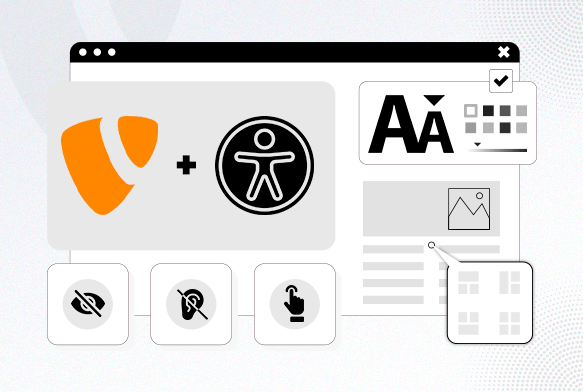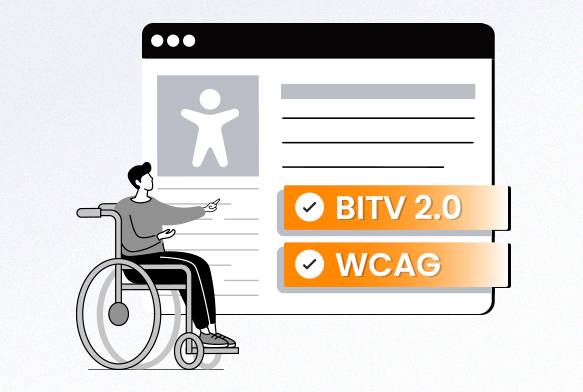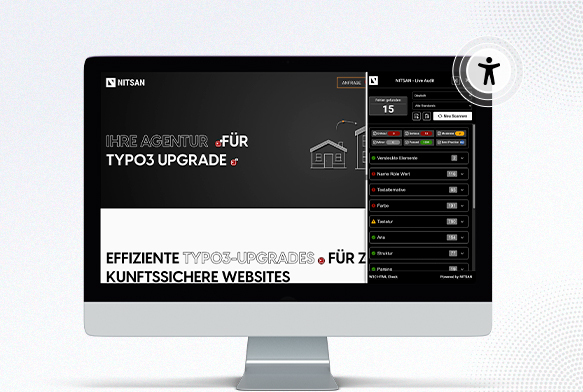Secure, Scalable, and Accessible for The Public Sector
We create powerful websites for the public sector using the open-source CMS TYPO3, designed to meet the unique needs of government and public institutions. Our comprehensive approach covers every step, from planning to implementation, ensuring websites that are accessible, scalable, and efficient.
This makes us the go-to experts for TYPO3 projects in the public sector, helping institutions connect with their communities and deliver essential services online.
As an experienced TYPO3 agency, we ensure that your website is optimized for both visitors and search engines. This turns more visitors into customers and improves your Google rankings at the same time.
Government Site Builder
The Federal Ministry of the Interior and Home Affairs has chosen Government Site Builder (GSB) version 11, built on TYPO3, as the foundation for federal IT consolidation. This decision highlights TYPO3’s position as a trusted solution for public sector projects, setting a clear standard for such initiatives.
NITSAN has years of experience with TYPO3 to help you effectively implement and optimise GSB 11. Our team focuses on simplifying processes, improving efficiency and providing secure, user-friendly platforms that meet the specific needs of public organisations.
Accessibility
in TYPO3
As an experienced TYPO3 agency, we not only build exceptional TYPO3 websites but also offer innovative solutions, a TYPO3 extension designed to enhance accessibility. Our work strictly follows the Web Content Accessibility Guidelines (WCAG 2.2) at levels A and AA, as well as the German Barrier-Free Information Technology Ordinance (BITV 2.0).
This commitment underscores our expertise in creating inclusive, user-friendly digital solutions while meeting the highest accessibility standards in TYPO3.
Why
NITSAN
We are NITSAN, a TYPO3 agency specialising in customised solutions for the public sector.
Stefan Reinhardt
Service Partner - Germany
+49 6204 6011377 | stefan.reinhardt@nitsantech.de
TYPO3 IS USED BY GOVERNMENT ORGANIZATIONS
The German federal government has adopted TYPO3 as the foundation for its Government Site Builder (GSB) version 11, recognizing its professional, accessible, secure, stable, and scalable open-source framework.
TYPO3 is an open source solution, which means that there are no license fees. This is a considerable advantage for public institutions, which generally work with limited budgets. The costs for operation are concentrated on individual adaptations, further developments and support from agencies such as NITSAN.
TYPO3 ensures accessibility compliance with BITV 2.0, WCAG 2.2, and EN 301 549 standards, meeting European accessibility requirements.
TYPO3 offers versions with long-term support (LTS). These LTS versions are provided with updates and security patches for several years, which offers long-term planning security. This is particularly valuable for public institutions that often have to pay attention to stability and maintenance costs.
By default, TYPO3 generates clean, semantic HTML code that is well structured and easier for screen readers to interpret. This is an important prerequisite for accessibility, as many assistive technologies rely on a clear and understandable structure.
The integrated multilingual support in TYPO3 makes it easier for public institutions to offer accessible content in several languages. In addition, the user-friendly maintenance interface makes it easy for non-technical staff to create and manage accessible content.
As many public institutions access their websites across multiple departments, TYPO3 offers a powerful user and rights system that simplifies the workflow for editors. It enables editors to maintain content without barriers and in accordance with the relevant regulations, without having to rely on in-depth technical knowledge.
TYPO3 is known for its flexibility and scalability. Public institutions can implement both small information sites and large, complex portals on the basis of TYPO3. The platform grows with the requirements and can also be expanded and adapted at a later date without having to change fundamental structures.
With TYPO3, specific design and layout requirements that are important for barrier-free pages (e.g. contrasts, font sizes, keyboard navigation) can be implemented in a targeted manner. TYPO3 offers a high degree of adaptability to individual guidelines and layout specifications.
Customers from the public sector



Your project
with NITSAN
As an experienced TYPO3 agency, NITSAN takes care of the complete technical implementation of your website - from the initial concept phase to implementation and final publication. Our team of experts ensures that all technical requirements are professionally realized. This includes complete programming, content integration and fine-tuning for a barrier-free and user-friendly web presence.
In addition, we offer long-term support contracts to ensure that your website always runs smoothly and remains secure. Whether regular updates, security checks or technical adjustments - NITSAN is at your side as a reliable partner and ensures that your TYPO3 website is optimally maintained and protected in the future.
Tenders
At NITSAN, we are aware that public institutions often award projects through tendering procedures. We are therefore happy to participate in tenders and ensure that all the required criteria are professionally fulfilled. With our many years of experience in dealing with public projects and tenders, we are ideally equipped to implement your requirements in the best possible way.
In addition, we can support you in the creation and management of tenders to ensure that technical requirements are clearly defined and suitable partners are involved. Our extensive know-how in working with other technical partners and many years of expertise in implementing public projects make us a valuable partner for any tender.
Stefan Reinhardt
Contact for SMEs and public institutions
stefan.reinhardt@nitsantech.de|+49 6204 6011377
SAY HELLO



